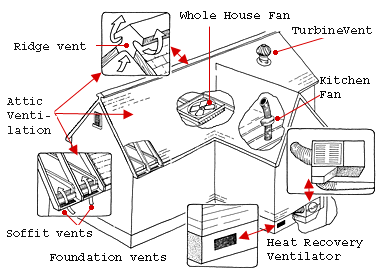Home > House Structure > Ventilation
Ventilation
Ventilation in a house refers to the process of exchanging indoor air with fresh outdoor air. It plays a crucial role in maintaining indoor air quality, controlling moisture levels, and ensuring a healthy and comfortable living environment. Proper ventilation helps remove pollutants, odors, and excess moisture from the indoor space, preventing the buildup of harmful substances and reducing the risk of respiratory problems, allergies, and mold growth.
There are several methods of achieving ventilation in a house:
• Natural Ventilation: This involves allowing air to enter and exit the house through openings such as windows, doors, and vents. Natural ventilation relies on wind pressure, temperature differences, and the stack effect (where warm air rises and is replaced by cooler air) to facilitate airflow.
• Mechanical Ventilation: Mechanical ventilation systems use fans or blowers to actively circulate air and remove stale air from the house. These systems can be classified into different types:
• Exhaust Ventilation: This system uses fans to extract air from specific areas prone to moisture or pollutants, such as bathrooms, kitchens, and laundry rooms. The extracted air is expelled outside, creating a negative pressure that draws fresh air in from other areas of the house.
• Supply Ventilation: In this system, fresh outdoor air is supplied to the house through fans or blowers. It helps maintain indoor air quality by diluting pollutants and providing a constant source of fresh air.
• Balanced Ventilation: This type of system combines both exhaust and supply ventilation. It ensures a balanced airflow by extracting stale air from specific areas while simultaneously supplying fresh outdoor air to other areas of the house.
• Heat Recovery Ventilation (HRV) and Energy Recovery Ventilation (ERV): These systems are designed to recover heat or energy from the outgoing stale air and transfer it to the incoming fresh air. This helps improve energy efficiency by reducing heating and cooling loads while ensuring proper ventilation.
• Natural Ventilation Strategies: Various design strategies can enhance natural ventilation in a house. These include the use of operable windows, cross-ventilation by placing windows or vents on opposite walls, and the inclusion of features like roof vents, skylights, or louvers to facilitate air movement.
Benefits of proper ventilation in a house include:
• Improved Indoor Air Quality: Ventilation helps remove pollutants, allergens, and odors, promoting a healthier living environment and reducing the risk of respiratory issues.
• Moisture Control: Proper ventilation prevents excessive moisture buildup, reducing the chances of mold and mildew growth and protecting the structural integrity of the house.
• Temperature Control: Ventilation can help regulate indoor temperatures by allowing fresh air to enter and removing excess heat or cold air.
• Energy Efficiency: Well-designed ventilation systems, such as HRV and ERV, can help improve energy efficiency by recovering heat or energy from the outgoing air.
• Comfort and Well-being: Adequate ventilation creates a more comfortable living environment by reducing stuffiness, improving air circulation, and eliminating stagnant air.
It is important to consider local climate, building design, and lifestyle factors when determining the appropriate ventilation strategy for a house. Consulting with a professional HVAC specialist or building engineer can help ensure an effective and efficient ventilation system tailored to the specific needs of the property.










